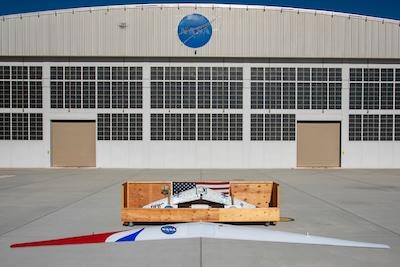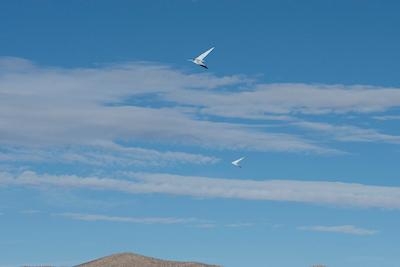Will Be Featured In An Upcoming Innovations Gallery At The Smithsonian
It’s not every day that a research aircraft may possibly change the way we build future planes. A new method of wing efficiency was discovered at NASA Armstrong Flight Research Center in California, by an aircraft built with a twisted wing and no tail.

After years of research, data collection and flight tests NASA Armstrong’s Prandtl-D aircraft has demonstrated the ability to enhance controllability. The aircraft will be shipped off to the prestigious National Air and Space Museum, Smithsonian Institution and the California Science Center in Los Angeles.
Preliminary Research Aerodynamic Design to Lower Drag, or Prandtl-D, is a student driven project that was introduced by former NASA Armstrong chief scientist Al Bowers. The goal of the Prandtl-D program is to gather data and test Ludwig Prandtl’s 1932 paper that details the best solution for aircraft wing efficiency. Prandtl proposed a non-elliptical bell-shaped form by considering the strength of a wing rather than just the wingspan, which may produce a lift distribution with 11 percent less induced drag.
Traditional airplanes are designed to create an elliptical span load distribution, which means an aircraft’s wings does not produce lift evenly across its wings. Instead when an airplane is flying there is a lift distribution across the wings that is carried in the shape of half an ellipse. The new span load lift distribution would distribute the lift in the shape of a bell curve due to its twisted wing.
NASA personnel selected groups of student interns each year from high school through graduate school that conducted, tested and integrated research on proverse yaw based on the 1932 paper. The aircraft was built with a twisted wing and no tail to test the theory of wing design optimization. The flight tests and data collected for Prandtl-D1 demonstrated that the new span load made the outer part of the wing have a higher pressure on top and a lower pressure underneath causing a positive thrust. Data collected from Prandtl-D’s test flights demonstrated by definition proverse yaw.

Prandtl-D1 was requested by Russell Lee, chairman of the aeronautics department at the Smithsonian because it was the first aircraft in history to demonstrate and record data on proverse yaw. Mr. Lee plans on featuring Prandtl-D1 in an upcoming Innovations Gallery at the Smithsonian.
The California Science Center also submitted a request for Prandtl-D3, a larger scale model of Prandtl-D1 that will be displayed in the near future.
The Prandtl program has become a high demand internship at NASA Armstrong for students across the nation. Since 2015 an average of 1,500 students apply each year and only 20 students are selected for a Prandtl summer internship.
The data gathered by Prandtl-D led engineers to also develop Prandtl-M, a concept for a Mars airplane that may collect and transmit valuable information back to Earth. Prandtl-M may be deployed and fly in the Martian atmosphere and capture high resolution topographic images as it glides down to inform scientist about the suitability of potential landing sites.
NASA Armstrong plans to continue the Prandtl program to gather research and data collection on proverse yaw through the non-elliptical bell-shaped span load distribution in the hopes to offer a new method of aircraft control and efficiency for future aeronautics.
(Images provided with NASA news release)
 Affordable Flying Expo Announces Industry MOSAIC Town Hall
Affordable Flying Expo Announces Industry MOSAIC Town Hall Classic Aero-TV: Composite-FX Sets Elevates the Personal Helicopter Market
Classic Aero-TV: Composite-FX Sets Elevates the Personal Helicopter Market Aero-News: Quote of the Day (10.25.25)
Aero-News: Quote of the Day (10.25.25) ANN's Daily Aero-Term (10.25.25): Ground Stop (GS)
ANN's Daily Aero-Term (10.25.25): Ground Stop (GS) NTSB Final Report: Gallow Daniel A Kitfox Classic IV
NTSB Final Report: Gallow Daniel A Kitfox Classic IV




